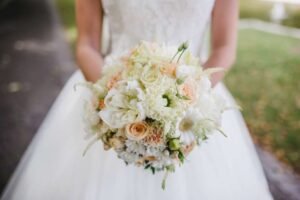How to Save Money on Wedding Flowers: 8 Top Tips for Budget-Friendly Blooms
Posted on |
Introduction
Wedding flowers play a significant role in setting the tone and atmosphere of your special day. However, they can also be a substantial part of your wedding budget. In this article, we will explore various strategies to help you save money on wedding flowers without sacrificing style or quality. Follow these top tips to achieve a beautiful floral display that won’t break the bank.
1. Use Flowers In Season
A key factor in saving money on your wedding flowers is selecting blooms that are locally grown and in season. Not only will this reduce transportation costs, but it also ensures that your chosen flowers are at their peak freshness and vibrancy.
A. Consult with Your Florist for Seasonal Recommendations
Your wedding florist is an invaluable resource when it comes to selecting seasonal flowers. Share your desired aesthetic, style, and color scheme with them, and let the florist suggest suitable options that fit within your budget.
B. Be Flexible in Flower Selection
To maximize savings, be open to considering various types of flowers for your bouquets, table centerpieces, and other floral arrangements. This flexibility will allow your florist to make the most of the available seasonal blooms, ultimately reducing costs.
2. Minimize Flower Choices
Another way to save money on wedding flowers is to limit the number of flower varieties in your arrangements. By doing so, you can take advantage of bulk purchasing discounts and reduce potential wastage.
The Benefits of Bulk Purchasing
When you choose fewer flower varieties, your florist can buy larger quantities of each type at a lower cost. This bulk purchasing strategy reduces the overall price per stem, resulting in cost savings for you.
Reducing Wastage and Labor Costs
By minimizing the number of flower varieties in your arrangements, you can also reduce the amount of labor required to prepare the flowers. This efficiency translates to lower costs for your wedding florist, which can be passed on to you in the form of savings.
3. Use Premium Flowers Sparingly
While premium flowers like peonies, David Austin roses, and phalaenopsis orchids can add a touch of elegance to your wedding, they can also significantly increase your floral budget. To strike a balance between luxury and affordability, consider using these high-end blooms sparingly.
Incorporate Premium Flowers in Key Areas
Rather than filling all of your arrangements with expensive flowers, strategically include them in focal points like your bridal bouquet or a statement centerpiece. This targeted approach allows you to enjoy the beauty of premium flowers without overspending.
Be Mindful of Regional and Seasonal Pricing Differences
When seeking inspiration for your wedding flowers, keep in mind that prices can vary depending on your location and the time of year. Flowers that may be affordable and abundant in one region could be more expensive and scarce in another. Be sure to consult with your florist to understand the pricing and availability of your desired blooms.
4. Prioritize Floral Elements
As you plan your wedding flowers, it’s essential to determine which elements are most important to you. By focusing on high-impact areas and skipping less necessary features, you can allocate your floral budget more effectively.
Maximize Impact with Strategic Flower Placement
Consider the areas of your wedding where floral arrangements will have the greatest visual impact. For example, if your ceremony is in a picturesque garden, you may not need a heavily decorated wedding arch or additional floral features at the altar. By prioritizing impactful placements, you can create a stunning effect without overspending on flowers.
Skipping Less Necessary Elements
To further optimize your floral budget, consider forgoing less essential decorations like rose petals on the ground or a flower toss during your exit. Additionally, if your reception venue has lower ceilings, you might choose to skip the more expensive elevated table centerpieces, as their impact could be diminished in a smaller space.
5. Have a Smaller Wedding
One straightforward way to save money on wedding flowers is to reduce the size of your guest list and bridal party. With fewer attendees, you’ll require fewer centerpieces, bouquets, boutonnieres, and other floral decorations.
Reducing the Number of Centerpieces and Bouquets
By having a smaller wedding, you can significantly decrease the number of floral arrangements you’ll need for your guest tables and bridal party. This reduction in quantity will directly translate to cost savings on your overall flower budget.
6. Re-Purpose or Re-Use Florals
Re-purposing your wedding flowers is another effective strategy to save money on wedding Flowers. By utilizing the same arrangements in multiple areas of your wedding, you can maximize their value and minimize costs.
Re-Using Flowers Throughout the Wedding
Consider ways to reuse floral arrangements at various points during your wedding. For example, bridesmaid bouquets can double as table centerpieces or decorations for the cake table. Similarly, flowers from the signing table can be repurposed as decor for the guestbook table.
Organizing Flower Transportation and Setup
To successfully re-purpose your flowers, you’ll need to coordinate their transportation and setup between the ceremony and reception venues. Enlist a trusted friend or family member to help with this task, ensuring your flowers continue to shine throughout the event.
7. Avoid Major Special Occasions
When planning your wedding date, try to avoid major holidays or special occasions like Valentine’s Day, Mother’s Day, or Christmas. During these times, the demand for flowers is typically higher, resulting in increased prices.
In addition to increased flower costs, scheduling your wedding during holiday periods may also limit your options for flower suppliers. Many growers and florists take time off around Christmas and New Year’s, potentially reducing the availability of certain blooms and vendors.
8. Combine Flowers with Other Décor Elements
To further stretch your floral budget, consider combining flowers with other decorative elements like candles, lanterns, and bud vases. These additional items can enhance the ambience and visual impact of your wedding without increasing your flower expenses.
Incorporating Candles and Lanterns
Candles are an affordable and versatile way to create a warm, inviting atmosphere at your wedding. Use a variety of candles with different heights, such as pillar candles and votive candles, for a dynamic effect. To further elevate the look, consider incorporating lanterns or bud vases into your tablescapes.
Experimenting with Unconventional Materials
For a unique and memorable wedding aesthetic, explore the use of unconventional materials in your floral arrangements. Examples include wire-mesh, decorative wire, or washi paper. By incorporating these inventive elements, you can create a one-of-a-kind floral display that leaves a lasting impression.
Conclusion
Saving money on wedding flowers doesn’t mean sacrificing quality or style. By following these tips, you can create a beautiful and budget-friendly floral display that enhances the ambience and aesthetic of your special day. Remember to consult with your florist, prioritize impactful arrangements, and stay open to creative and unconventional ideas. With careful
Frequently Asked Questions
1. What flowers are typically in season for a wedding?
The availability of flowers in season varies depending on your location and the time of year. Some popular seasonal flowers include:
Spring: tulips, daffodils, hyacinths, peonies, and lilacs
Summer: roses, sunflowers, hydrangeas, dahlias, and zinnias
Fall: chrysanthemums, asters, celosia, amaranthus, and marigolds
Winter: amaryllis, anemones, ranunculus, hellebores, and camellias
Always consult with your local florist to determine which flowers will be in season for your wedding.
2. How can I repurpose my wedding flowers?
There are several ways to repurpose wedding flowers, including:
Using bridesmaid bouquets as table centerpieces or cake table decorations
Reusing ceremony flowers for the reception, such as relocating altar arrangements to the head table
Repurposing signing table flowers for the guestbook table
To successfully repurpose flowers, coordinate their transportation and setup between venues and enlist help from a friend or family member.
3. How do I choose the right florist for my wedding?
When selecting a wedding florist, consider the following factors:
- Experience and expertise in creating the style you envision
- Availability on your wedding date
- Willingness to work within your budget
- Positive reviews and recommendations from previous clients
- Effective communication and collaboration
- Schedule consultations with multiple florists to compare their offerings and find the best fit for your needs.
4. How much should I budget for wedding flowers?
The amount you should allocate for wedding flowers depends on factors such as your overall wedding budget, the number of guests, the size of your bridal party, and the desired level of floral decor. On average, couples spend between 8% and 10% of their total wedding budget on flowers. However, this percentage can vary based on your individual preferences and priorities.
5. Can I use silk flowers instead of fresh flowers to Save Money on Wedding Flowers?
Using silk flowers can be a cost-effective alternative to fresh flowers in some cases. High-quality silk flowers can be more affordable than premium fresh flowers and can be repurposed or resold after the wedding. However, keep in mind that the overall look and feel of silk flowers may be different from fresh flowers, and some couples prefer the natural beauty and scent of real blooms.
6. Can I mix and match flowers of different price points to Save Money on Wedding Flowers?
Yes, mixing and matching flowers of different price points is an effective way to save money while still achieving a beautiful floral display. By using premium flowers sparingly and filling out arrangements with more affordable options, you can create a balanced look that meets your budget requirements.
7. How can I use candles and other non-floral elements to enhance my wedding decor?
Incorporating candles and other non-floral elements into your wedding decor can provide visual interest, create ambience, and stretch your floral budget. Some ideas include:
- Using pillar candles, votive candles, and tea lights of varying heights to create dynamic tablescapes
- Incorporating lanterns, bud vases, or decorative bowls to add depth and dimension to your arrangements
- Using greenery, such as ferns, eucalyptus, or ivy, as an affordable alternative to flowers in some areas of your wedding
8. What are some unconventional materials I can use in my floral arrangements?
For a unique and memorable wedding aesthetic, you can explore the use of unconventional materials in your floral arrangements. Examples include:
- Wire mesh, which can be shaped into interesting forms and structures
- Decorative wire, which adds a modern, industrial touch to your arrangements
- Washi paper, which can be used to create delicate, handcrafted flowers or accents
By incorporating these inventive elements, you can create a one-of-a-kind floral display that leaves a lasting impression.
9. How far in advance should I book a wedding florist?
It’s generally recommended to book your wedding florist at least six to nine months in advance of your wedding date. This timeline allows for ample planning, coordination, and sourcing of flowers. However, if you have a specific florist in mind or are planning a wedding during peak season, you may want to book even earlier to ensure their availability.
10. Can I DIY my wedding flowers to save money?
While DIYing your wedding flowers can potentially save money, it’s essential to consider the time, effort, and skill involved in creating professional-looking arrangements. If you’re confident in your abilities and have the time to dedicate to this task, it may be a viable option. However, enlisting the help of a professional florist can ensure a stress-free experience and high-quality results.







